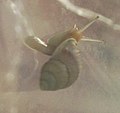Top Qs
Timeline
Chat
Perspective
Partula (gastropod)
Genus of gastropods From Wikipedia, the free encyclopedia
Remove ads
Partula is a genus of air-breathing tropical land snails, terrestrial pulmonate gastropod mollusks in the family Partulidae.[2][3]
This article needs additional citations for verification. (June 2024) |



Many species of Partula are known under the general common names "Polynesian tree snail" and "Moorean viviparous tree snail".[4] Partulids are distributed across 5,000 sq mi (13,000 km2) of Pacific Ocean islands, from the Society Islands to New Guinea.[5]
Once used as decorative items in Polynesian ceremonial wear and jewelry, these small snails (averaging about one-half to three-quarters of an inch in length) gained the attention of science when Dr. Henry Crampton (along with Yoshio Kondo) spent 50 years studying and cataloging partulids, detailing their remarkable array of morphological elements, ecological niches, and behavioral aspects that illustrate adaptive radiation.[6][5]
Remove ads
Decline
Summarize
Perspective
The partulids of the island of Tahiti act as an example of the possible deleterious effects of attempted biological control. After an infestation of the introduced giant African land snails (Achatina spp.), the carnivorous Florida rosy wolfsnail (Euglandina rosea) was introduced into Tahiti in an attempt to combat the African species.
Instead, the rosy wolfsnail hunted the nearly 76 species of Partula that were endemic to Tahiti and the nearby islands, causing all but 12 species to go extinct within a decade. Scientists were able to save 12 of these species prior to their becoming extinct.[citation needed]
Today, the Zoological Society of London runs the Partula Programme Consortium which maintains a captive-breeding programme in the United Kingdom, France, and the United States.[7]
As of the 2024 update released on June 27, the IUCN Red List of Threatened Species contains 73 Partula species. Of these, 32 are listed as extinct, 10 are extinct in the wild, 17 are critically endangered, 8 are endangered, 2 are vulnerable, and only 4 species are least concern.[8]
Individuals are being reintroduced to Tahiti from captive breeding programmes since 2014.[9][10] In April 2023, over 5,000 individual snails from zoos in the United States and the United Kingdom were released on Tahiti and Mo'orea.[citation needed]
Remove ads
Species
Summarize
Perspective
Species within the genus Partula include:[5]
Full list
- The species pages are currently outdated because of the IUCN 2024-1 update.
- The list may be currently missing some species. If you notice a missing species please add it.
Collected for ex situ conservation
The Partula that were collected for ex situ breeding include the following:[12]
Tahiti - P. affinis, P. clara, P. hyalina, P. nodosa, P. otaheitana
Moorea - P. aurantia, P. mirabilis, P. mooreana, P. suturalis, P. taeniata, P. tohiveana
Huahine - P. arguta, P. rosea, P. varia
Raiatea - P. faba, P. garrettii (P. tristis), P. hebe, P. navigatoria (P. dentifera), P. turgida
Marianas - P. gibba, P. langfordi

P. garrettii and P. navigatoria were misidentified as the species in parentheses next to them.
Surviving species
The list of surviving species are as follows:[8]
Tahiti - P. affinis, P. clara, P. hyalina, P. incrassa, P. nodosa, P. otaheitana
Moorea - P. mirabilis, P. mooreana, P. suturalis, P. taeniata, P. tohiveana
Raiatea - P. garrettii (P. tristis), P. hebe, P. meyeri, P. navigatoria (P. dentifera)
Marianas - P. gibba, P. langfordi, P. lutaensis, P. radiolata
Micronesia - P. emersoni, P. rufa
Fiji - P. leefei, P. lirata
Solomon Islands - P. cramptoni, P. micans
Papua New Guinea - P. auraniana, P. similaris
Cook Islands - P. assimilis
Remove ads
Cladogram
Summarize
Perspective
Phylogenetic analyses revealed that many of the Partula species are not monophyletic.[13] The resulting cladogram is shown below.
| Partulidae |
| |||||||||||||||||||||||||||||||||||||||||||||||||||||||||||||||||||||||||||||||||||||||||||||||||||||||||||||||||||||||||||||||||||||||
Remove ads
Ecology
Partula species on Tahiti were usually found on the undersides of the leaves of Caladium and plantain, although in some valleys, they were frequently found on Dracaena and turmeric.[14]
Gallery
Tahitian species
- Partula incrassa
Moorean species
Huahine species
Raiatean species
Mariana Islands species
- Partula langfordi (extinct)
Remove ads
References
Further reading
External links
Wikiwand - on
Seamless Wikipedia browsing. On steroids.
Remove ads












